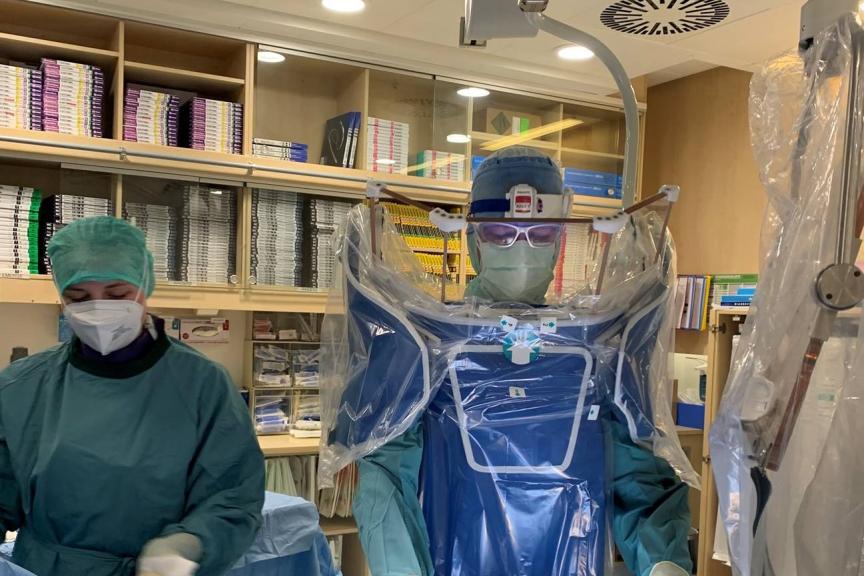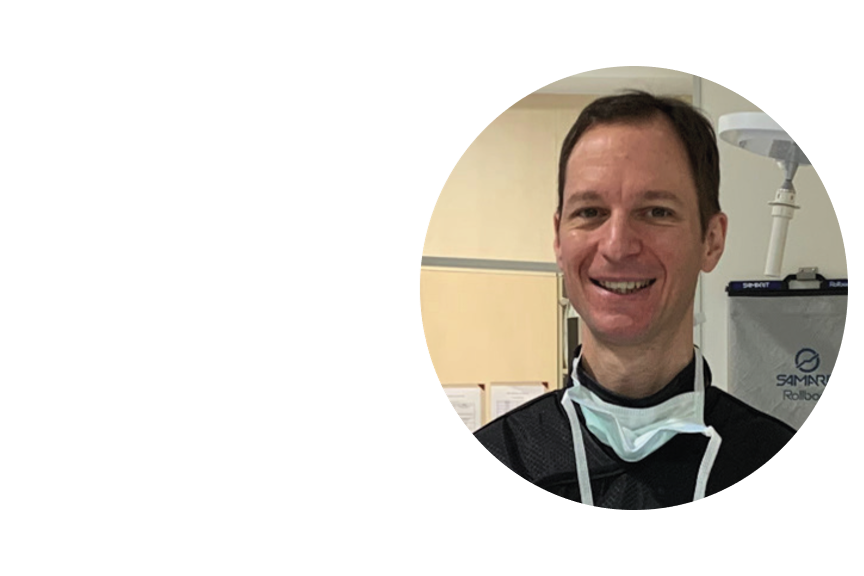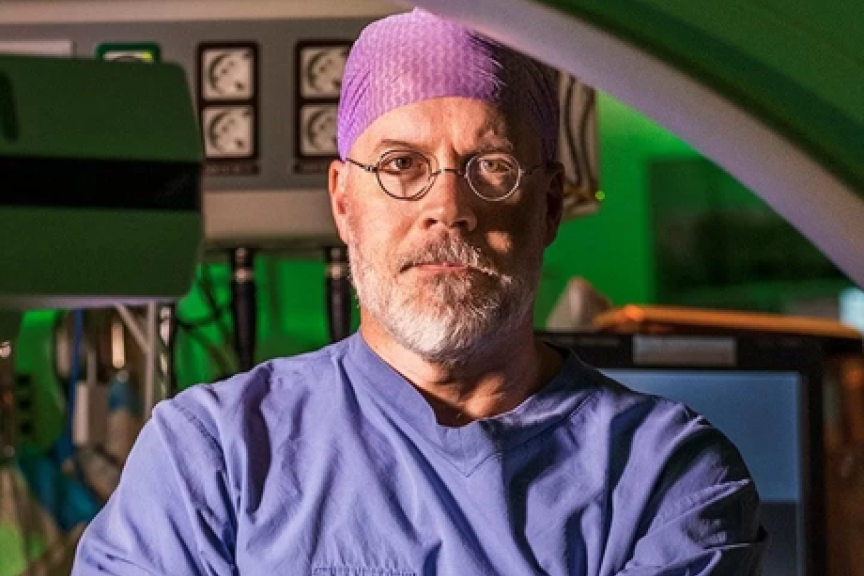Radiation and Occupational Safety in Interventional Cardiology
Cardiac catheterization labs can be complicated workplaces when it comes to occupational safety.

Physicians and nursing staff are working in proximity to a radiation source, and some of the most vulnerable areas of the body are not covered by standard X-ray protection [1, 2]. Chronic exposure to radiation can lead to serious health effects, including cataracts and brain tumors [3].
In addition to radiation concerns, X-ray protection garments put significant strain on the musculoskeletal system due to their weight. After only five years, 85 percent of physicians working in interventional settings complain of pain or damage to the spine [4]. Each additional element in radiation protection garments means more weight for staff to bear. Is there a solution for this dilemma? Interventional cardiologist Dr. Mathias-Christoph Brandt, senior physician at the University Clinic Salzburg, and his colleagues demonstrate that there is one. Using the Zero-Gravity system, cathlabs can optimize both radiation protection and occupational safety.
A Glimpse Into the Working Environment of Interventional Cardiologists
Interventional cardiologists spend the major part of their working day at the cathlab table, typically wearing an X-ray apron that weighs 15-20 lbs. Complex interventions can take a long time – with single procedure durations up to two hours.
"I work mainly in the cathlab, where I spend up to 90 percent of my working time. My day at the cathlab table starts at 7:30 a.m. with the first cases. The core working hours actually end at 4:00 p.m. – but our services are often needed long beyond that, especially during emergency procedures," reports Dr. Brandt. "We pay for our work with a high probability of damage to our health."
What Risks Are Physicians Exposed to in the Cardiac Catheter Laboratory?
A worrying picture emerges from several studies and surveys of interventional cardiologists. Fifty percent of them have cataract precursors of the eye lens [5]. They also see a high frequency of atherosclerosis of left-side neck vessels [2], and up to 85 percent of those reported of either spinal complaints or muscle pain [4]. These orthopedic concerns can be attributed to the weight of radiation protection garments and resulting postural damage.
"In addition,” Dr. Brandt stresses, “we are seeing a worrying cluster of aggressive brain tumors among interventional cardiologists who have worked in catheter laboratories for many years. These occur on the left side in 85 percent of the cases, i.e. on the side of the radiation source, and have a very poor prognosis."
Current Protection Does Not Seem Optimal
Despite their weight, conventional lead aprons with thyroid protection offer insufficient protection against scatter radiation. "Lead aprons have large cutouts for the arms on both sides. However, at the cathlab table, we work with the left side of the body pointing towards the X-ray source, so that radiation has a wide entry path through the shoulder, propagating into the chest almost without any attenuation. This is a risk for chronic radiation damage. We know that medical staff working in the cathlab has a higher risk of sarcomas in the mediastinum – and female colleagues a higher risk of breast cancer," explains Dr. Brandt. In addition, the lenses of the eyes and the head are not protected by conventional lead aprons. Although lead protection glasses provide a certain degree of attenuation, scatter radiation reaches the head of the operator from the lower left side and usually bypasses lead protection glasses altogether, affecting the lenses from an oblique inferior angle.
That's why two years ago, the interventional cardiology team at University Clinic Salzburg installed the Zero-Gravity System. "This system, guided by a hinged arm on a ceiling rail, has a much stronger radiation armor for the body. It extends down to the lower legs and is supplemented by protectors for the shoulders and a face shield of acrylic lead glass that protects the eyes and head from scatter radiation," explains Dr. Brandt. "And the best of all: The system is completely weightless for the operators! We have initiated the OSCAR Registry[6], a scientific project using digital live dosimeters to investigate the actual level of scatter radiation exposure for operators and assistants in daily clinical practice. “Despite a fully equipped cathlab setup with all standard radiation protection tools in place, including a ceiling-mounted lead shield, under-table lead protection, and patient lead cover, there was a substantial amount of scatter radiation exposure for the team”, explains Dr. Brandt. "When we saw the data from procedures performed with Zero-Gravity, we were simply blown away! Zero Gravity provided up to 97 percent reduction of scatter radiation at critical anatomical areas of the examiners. This effect was present independent of procedure type and independent of a range of other procedure and patient variables."

I am very grateful that the University Clinic Salzburg has invested in the Zero-Gravity system. In addition to this improved radiation protection at the workplace, our Clinic is offering health and prevention programs for employees. I know from my own experience that good occupational health and safety are extremely important.
Zero-Gravity Contributes to Efficient Occupational Safety
Zero-Gravity helped Dr. Brandt and his team solve two problems of classic radiation protection systems at the same time. Firstly, Zero-Gravity eliminates chronic weight load on the hips, shoulders and spine. Secondly, Zero-Gravity protects sensitive areas of the body against radiation with the lead-acrylic glass visor and additional shoulder flaps. A recent study confirmed the efficient radiation protection of the system: For main operators, the scatter radiation could be reduced by more than 90 percent compared to conventional lead aprons.
"I know from daily practice that Zero-Gravity has one further advantage: Since the system is mounted at the ceiling next to the cathlab table, as the operator I only wear the system when I really need it – directly at the table when using fluoroscopy. As soon as I step away from the table, whether to the control room for further image analysis or to the locker room, I'm already free of any heavy protection garments. This optimizes our workflow in the lab and results in an increased efficiency," adds Dr. Brandt.
Employer Attractiveness Is Also Characterized by Health Prevention Programs and High Occupational Safety Standards
Good occupational safety measures and health prevention programs benefit all employees and increase a hospital’s attractiveness as an employer. "I am very grateful that the University Clinic Salzburg has invested in the Zero-Gravity system. In addition to this improved radiation protection at the workplace, our Clinic is offering health and prevention programs for employees. I know from my own experience that good occupational health and safety are extremely important. Therefore, my recommendation for all interventionalists is to take a critical look at their workplace, and the impact it has on their health – the current standard of occupational safety is just not enough," states Dr. Brandt.
References:
1. Picano, E.; Vano, E.; Domenici, L.; Bottai, M.; and Thierry-Chef, I. Cancer and non-cancer brain and eye effects of chronic low-dose ionizing radiation exposure. BMC Cancer 2012, 12: p. 157.
2. Andreassi, M.G.; Piccaluga, E.; Gargani, L.; Sabatino, L.; Borghini, A.; Faita, F.; Bruno, R.M.; Padovani, R.; Guagliumi, G. ; and Picano, E. Subclinical carotid atherosclerosis and early vascular aging from long-term low-dose ionizing radiation exposure: a genetic, telomere, and vascular ultrasound study in cardiac catheterization laboratory staff. JACC Cardiovasc Interv, 2015. 8(4): p. 616-27.
3. Roguin, A.; Goldstein, J.; Bar, O.; and Goldstein, J.A. Brain and neck tumors among physicians performing interventional procedures. Am J Cardiol, 2013. 111(9): p. 1368-72.
4. Klein, L.W.; Tra, Y.; Garratt, K.N.; Powell, W.; Lopez-Cruz, G.; Chambers, C.; Goldstein, J.A.; Society for Cardiovascular Angiography and Interventions. Occupational health hazards of interventional cardiologists in the current decade: Results of the 2014 SCAI membership survey. Catheter Cardiovasc Interv, 2015. 86(5): p. 913-24.
5. Vano, E.; Kleiman, N.J.; Duran, A.; Romano-Miller, M. ; and Rehani, M.M. Radiation-associated lens opacities in catheterization personnel: results of a survey and direct assessments. J Vasc Interv Radiol, 2013. 24(2): p. 197-204.
6. Brandt, M.C.; Prinz, E.; Schernthaner, C.; Kraus, J.; Wintersteller, W.; Hammerer, M.; Strohmer, B.; Lichtenauer, M.; Motloch, M.; Hoppe, U.C.; Nairz, O. Advanced radiation protection in PCI and diagnostic procedures with a ceiling-suspended radiation protection system - Data from the OSCAR Registry. JACC 2021. 78(19 Suppl. B): p. B63-B64.

